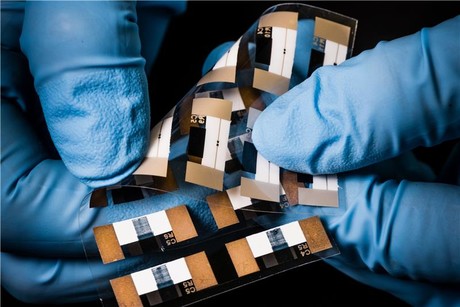Precise control of printed electronics

Researchers at Linköping University’s Laboratory of Organic Electronics (LOE) have demonstrated success creating printed electronic transistor circuits and displays in which the colour of individual pixels can be changed. Writing in the journal Science Advances, the researchers revealed their favourite material to work with: the conducting polymer PEDOT:PSS, which conducts both electrons and ions.
Displays and transistors manufactured from PEDOT:PSS have many advantages: they are simple and cheap to manufacture, and the material itself is non-hazardous. It has, however, been difficult to create devices that switch rapidly at a specific voltage, known as the ‘threshold voltage’. This means that it has been difficult to control the current state of the transistors or the colour state of the displays in a precise manner.
“The lack of any threshold in the redox-switching characteristics of PEDOT:PSS hampers bistability and rectification — characteristics that would allow for passive matrix addressing in display or memory functionality,” said Simone Fabiano, a senior lecturer at LOE and principal author of the new study.
A few years ago, LOE researchers wondered if they could solve this problem by combining electrochemistry with ferroelectricity. Ferroelectric materials consist of dipoles, with one end having a positive charge and the other having a negative charge. These ferroelectric dipoles rotate when they are exposed to an electric field beyond a specific threshold.
When laboratory head Professor Magnus Berggren was awarded a research grant from the Knut and Alice Wallenberg Foundation in December 2012, this was one of the high-risk projects he chose to invest in. Now, after many years of experiments, Fabiano and his colleagues at LOE have managed to apply a thin layer of a ferroelectric material onto one electrode in organic electrochemical devices and circuits.
“The thickness of the layer determines the voltage at which the circuit switches or the display changes colour,” said Fabiano. “Transistors are no longer required in the displays: we can control them pixel by pixel simply through a thin ferroelectric layer on the electrode.”
The researchers have thus demonstrated that ‘ferroelectrochemistry’ — the combination of ferroelectricity and electrochemistry — can be used in displays in the field of printed electronics and in organic transistors. The scientists envisage, however, many other areas of application.
“Ferroelectrochemical components can easily be integrated into memory matrices and into bioelectronic applications, just to give a couple of examples,” said Fabiano.
Supercapacitor tech outperforms batteries in power delivery
Engineers from Monash University have created a carbon-based material which allows...
Computer hardware advance solves optimisation challenges
A new hardware advance could redefine how industries solve large-scale optimisation challenges,...
‘Microwave brain’ chip for ultrafast, wireless computing
Researchers have developed a low-power microchip called ‘microwave brain’ — a...








